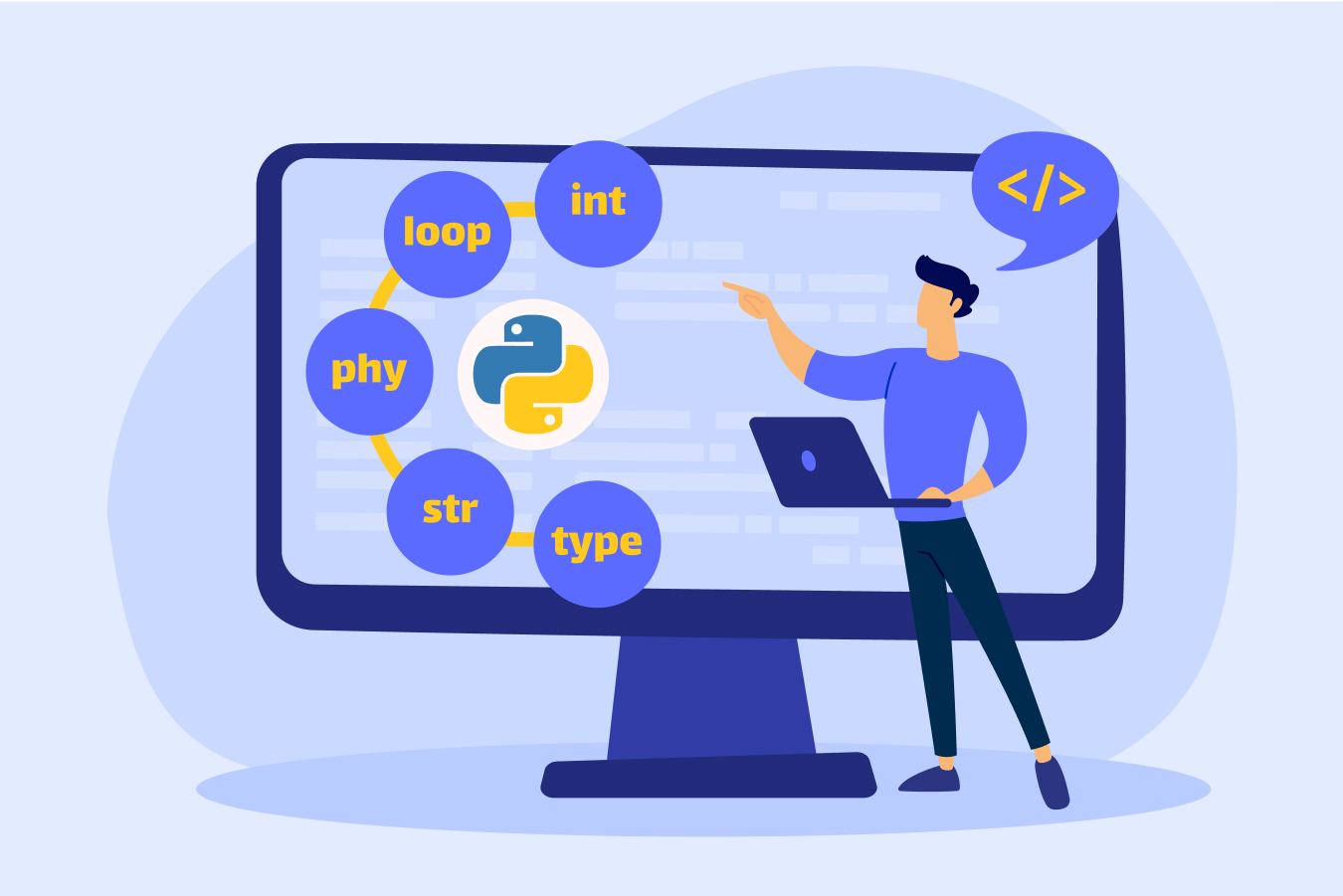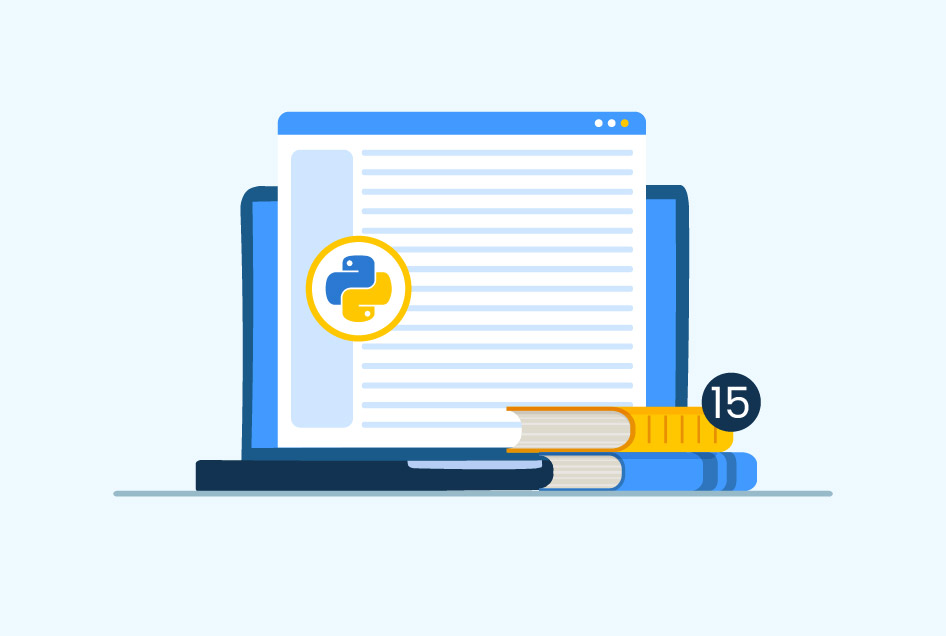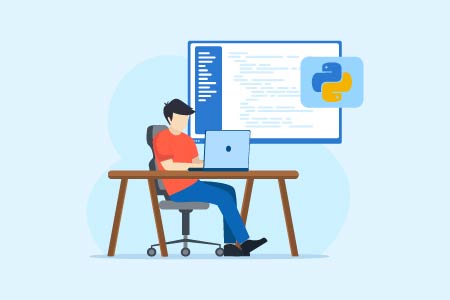Python Libraries & How Are They Used?
Libraries in Python help developers save time and energy. With libraries, pre-written code can be reused instead of creating a new one for every project.
Python libraries offer numerous functionalities such as deep learning and natural language processing that can optimize development processes while also making it easier for teams to collaborate on projects.
In this blog, we will look into Python libraries and explore their advantages in programming. We’ll also discuss some of the most commonly used ones for activities such as deep learning and visualization. Whether you’re an experienced developer wishing to grow your skillset or a novice wanting to understand how beneficial these are, this blog is for you.
What is a Library in Python?
Python libraries consist of pre-written code which allows developers to save time when writing their programs. With over 137,000 available libraries, Python can be used in a variety of fields from machine learning and data science to data visualization and image manipulation.
A library is essentially made up of codes or python modules for carrying out specific tasks without having to create the same code every time while writing a program. This is made possible by Windows Dynamic Load Libraries (DLL). To use methods in a library, you need to link it with your own application before running it. Once executed by the loader, these functionalities will be extracted automatically, allowing interpretation as required. If you wish to gain a better understanding of Python libraries, consider pursuing a comprehensive Python course.
What is the Python Standard Library?
The Python standard library is an essential part of the Python programming language, providing syntax, semantics, and tokens that form its foundation. The components of this library are written primarily in C code, with over 200 core modules included to allow access to fundamental system functionality such as input/output management. It also enables advanced features including high-level data structures like dictionaries and lists.
This foundational support makes Python a powerful yet easy-to-use higher-level language for developers around the world. Without it, many useful functions simply wouldn’t be possible. Aside from these basic libraries, there exist other specialized collections targeted at specific tasks, allowing coders extra flexibility during development cycles.
Top Python Libraries
Now that we have a basic understanding of libraries in Python, let’s take an in-depth look at some of the most popular libraries used in Python.
1. NumPy Library in Python
NumPy is the primary tool for numerical computing in Python and features a powerful N-dimensional array object. It tackles slow speed by offering multidimensional arrays combined with optimized functions/operators in python, which operate quickly. It has an abundant community of contributors on GitHub, with 18,000 comments from 700 active members that use it as their go-to package for general array processing needs due to its high performance.
Features:
- Providing fast precompiled routines
- Efficient array-oriented computation
- Support of an object-oriented approach
- Compact vectorized computations which lead to faster operations
Importance
- NumPy enables efficient manipulation of arrays with various dimensions.
- Code from other languages is easily incorporated into NumPy, enhancing cross-platform functionality.
- The array data type supported by NumPy provides a comprehensive container for diverse types of data analysis.
- Complex mathematical operations such as linear algebra can be done quickly with NumPy.
- Broadcasting simplifies array operations to make computations more streamlined and consistent.
- Different kinds of flexible data structures are allowed in order for precise datatype manipulations on NumPy.
Python arrays are one of the important topics you should learn before starting with Python libraries.
2. Keras
Keras is an incredibly useful library for creating deep learning and neural network models, offering easy-to-use tools. It works with both TensorFlow and Theano backends while providing datasets to quickly import networks as well as a vast choice of layers and parameters which aid in setting up, training, and evaluating AI models. Additionally, it has ‘pre-trained’ weights to offer. This makes the process of predictions simpler than ever before without requiring new builds all the time.
Features:
- Compatible with both CPU and GPU.
- It accommodates nearly all neural network models.
- Its modularity allows for great expressiveness, flexibility, and research potentiality.
Importance:
- Keras’ user-friendly interface makes it a great option for beginners, providing an accessible platform to construct their models quickly and effectively.
- Building with Python is effortless when using Keras. Its integration allows users to write efficient code rapidly without any complications or issues arising throughout the development process.
- Robust platforms like TensorFlow and Theano are fully supported by Keras as powerful backends in order for accelerated calculations during computation processes to take place successfully within this framework.
- Many advanced applications have been created such as Deepjazz Eclipse Picasso, AutoKerasi, etc.
3. Theano
Theano is a Python library for numerical computation designed to support deep learning and machine learning. It enables users to define, optimize, and analyze mathematical expressions, such as multi-dimensional arrays, which are the building blocks of many AI applications.
Utilizing CPUs or GPUs, Theano provides features like automatic differentiation, memory usage control, and numerical stability. This allows for efficient training and testing of models in scientific computing tasks. It includes simulations and optimizations as well as specific AI tasks such as deep learning.
Features:
- An image is defined by its three elements: num channels, width, and height.
- Sounds or time sequences are measured as a single element and their length in time units from start to finish point on the timeline axis.
- Arrays of two dimensions can be used to represent natural language sequences, consisting of the length of time and the size of the vocabulary.
Importance:
- Theano can recognize unstable expressions and substitute them with more dependable alternatives for evaluation.
- Through the utilization of recent GPUs, Theano is capable of executing components in both CPUs or GPUs which dramatically increases its speed compared to regular Python code execution speeds.
- It has a built-in feature called symbolic differentiation that automatically generates symbolic graphs used for computing gradients.
4. TensorFlow
TensorFlow is one of the most popular Python libraries for data science. It comes with a vibrant community consisting of over 1,500 contributors and 35k+ comments. TensorFlow can be especially helpful when used on applications such as speech/image recognition, text-based apps, time series analysis, and video detection in python projects.
Features:
- Better computational graph visualizations that reduce errors by up to 60% in neural machine learning.
- Parallel computing allows complex models to be executed quickly.
- Seamless library management backed by Google.
- Quick updates each containing new releases and advanced capabilities.
Importance
- TensorFlow offers a straightforward and simple syntax essential for making programming more user-friendly, despite the complexity of machine learning technology.
- Its high-level operations enable complex computation and easy development of neural network models, making it one of the most powerful deep learning frameworks available.
- It’s a low-level library that emphasizes flexibility, enabling researchers to customize functions and services for use in model construction. It creates a high degree of usefulness due to the ability to modify models as needed.
- The network control offered by TensorFlow also gives developers/researchers insight into how tasks are set up across the program’s modules, allowing them to keep track regarding any alterations done during execution.
5. ELI5
ELI5 is a Python library for debugging and interpreting machine learning models. It offers features such as feature importance, permutation imports, SHAP values, and model weight/bias visualization to help data scientists understand how their models work while digging into potential issues.
Additionally, it can generate user-friendly explanations of predictions which enable better communication with non-tech people involved in the project. Its use cases include model interpretation, comparison, and debugging.
Features:
- Visualization of model weights and biases is enabled.
- Comprehensive analysis is possible due to its support.
- Explanations for predictions can be generated.
- Model interpretation, comparison, and debugging are made easier.
Importance:
- It allows for easy calling of pre-existing functions and formatting the results.
- Reusing code between ML frameworks is made simpler with ELI5.
- It automates many small but significant details in coding processes.
6. LightGBM
LightGBM is a popular Python library that enables data scientists to implement gradient-boosting algorithms for large datasets in high-dimensional feature spaces. It provides ease of integration with other libraries such as Pandas, Scikit-Learn, and XGBoost while being efficient in terms of speed and memory usage.
The adjustable hyperparameters can be customized according to different use cases making them suitable for various applications like anomaly detection, time series analysis, natural language processing, and classification tasks.
Features:
- Light is a fast, distributed gradient-boosting framework.
- It’s based on decision tree algorithms.
- Suitable for ranking, classification, and many other machine-learning tasks.
- Notably fast, hence the name “Light”.
Importance:
- Higher efficiency and faster training speed.
- Lower memory consumption.
- Boosting algorithm with better accuracy than any other of its kind.
- Able to work effectively on large datasets.
- Parallel learning is an available option.
7. Matplotlib
Matplotlib is an open-source library in the Python programming language that stands out among all of the libraries we have discussed due to its extensive range of capabilities relating to dimensional plotting. This powerful tool makes it easy for developers and data analysts to create the following with only a few lines of code:
- Charts
- Graphs
- Pie charts
- Scatterplots
- Histograms
- Error charts
Features:
- Built on NumPy arrays and designed for SciPy stack compatibility.
- Powerful data visualization tool for comprehending large datasets.
- Offers 2D graphic plotting and visualization.
- Can work as a replacement for the more complex MATLAB.
Importance:
- It offers an uncomplicated way to access extensive amounts of data.
- It is adaptable and allows for various forms of data illustration.
- Its navigation system is simple to use.
- High-quality images are made available by the program, creating accessibility.
- As a powerful software with several uses, it has plenty of practical applications.
- Advanced charts can be created using this tool.
- It’s open-source, which means you get great savings on purchase costs.
- The range and personalization options it provides make Matplotlib rich in features.
- Can function properly across multiple platforms.
- Data interpretation becomes easier as a result of deploying Matplotlib.
8. NLTK
Natural Language Processing (NLP) tasks such as speech recognition, language detection, and machine translation can be done using NLTK. The NLTK library is a collection of libraries and applications for statistical natural language processing in Python. It offers tools to enable computers to comprehend human language through tokenization, sentiment analysis with a built-in classifier, names/stop words removal from recommendation systems, etc.
Although it supports the largest number of languages compared to similar packages, it has a high difficulty level plus a slower speed, making it unsuitable for real-world production usage. Its popular applications include sentiment analysis on reviews, building chatbots, or any other NLP-related activities like speech recognition, language detection, and machine translations.
Features:
- Facilitates Natural Language Processing (NLP) tasks such as speech recognition, language detection, and machine translation.
- Set of libraries and apps for carrying out statistical NLP using Python programming language.
- Helps computers comprehend human languages through tokenization and sentiment analysis methods.
- Contains an inbuilt classifier to conduct sentiment analysis operations easily.
Importance:
- NLTK is the most renowned and comprehensive NLP library with a large selection of third-party extensions available.
- It offers support for more languages than any other comparable libraries in the market today.
9. OpenCV Python
OpenCV, which stands for Open Source Computer Vision, is a software package written in Python designed to facilitate computer vision. It includes several built-in functions that enable users to learn more about the concepts of image processing and machine learning.
The library can be used both for reading and writing images as well as detecting objects, such as faces or trees from digital photos and videos, respectively. This powerful program is also platform-independent meaning it supports various operating systems like Windows, OSX, etc.
Features:
- Multiple user interfaces
- Programming library of functions
- Detection of object/feature
- Discussion forums/communities
Importance:
- OpenCV is used by companies like IBM and Google as well as startups such as Zeitera, for a variety of tasks due to its expansive collection of 2,500 advanced algorithms.
- With tools provided by the OpenCV community, it enables developers to ask questions, seek advice, and take code support from one another when needed.
- OpenCV has impressive real-time processing abilities that take advantage of hardware acceleration on multi-core systems, making operations more efficient.
10. Pandas Library in Python
Pandas is a powerful Python library designed to work with structured data easily and intuitively. It has eloquent syntax, rich functionalities, and high-level abstraction capabilities which are beneficial in general data wrangling (cleaning & preparation) jobs like ETLs (extracting, transforming, and loading).
This open-source tool consists of more than 1200 contributors who have contributed over 1700 comments on GitHub showcasing its widespread popularity across all commercial areas. These areas include finance and neuroscience to the more recent Artificial Intelligence applications like Natural Language Processing and Computer Vision.
Features:
- Intuitive data manipulation is made easy with eloquent syntax.
- A variety of data-wrangling tasks can be accomplished using the advanced features it offers.
- Data cleansing and preparation have been simplified through its high-level abstractions.
- It’s ideally suited for ETL (Extract, Transform, Load) operations.
<H4> Importance:
- Enhancing data science and review with efficient encoding techniques.
- Process large datasets quickly to save time when doing data analysis research.
- Offers a variety of characteristics that make it easier to analyze the information at hand.
- Relying on Python’s many features and libraries for maximum flexibility.
- Customizing your results is made simple so you can get thorough insights from all available metrics.
11. Pyglet
Pyglet is an object-oriented programming tool that provides a powerful way of creating interactive and visually appealing applications for Mac OS X, Windows, and Linux. It has the potential to revolutionize game development by making it easier than ever before to develop games like Minecraft was back in the 90s.
Pyglet comes with numerous features such as windowing processing user interface events (like joysticks), OpenGL graphics loading pictures/movies & playing sounds allowing developers to create an immersive gaming experience from home.
Features:
- Window processing user interface events (like joysticks)
- OpenGL graphics allow developers to create an immersive gaming experience at home.
Importance:
- No extra setup is required to use Pyglet.
- One of the benefits of using Pyglet is that it allows us to have multiple windows and utilize multi-monitor desktops simultaneously.
- Pyglet works with many different file formats when it comes to loading images, sound effects, background music, or video content into our projects.
- Lastly, we can make use of this library both commercially as well as in free open-source initiatives.
12. SciPy
SciPy is a free and open-source Python library for data science used to perform high-level computations. It has around 19,000 comments on GitHub as well as an active community of 600 contributors who use it extensively for scientific or technical purposes due to its capabilities that extend beyond NumPy with user-friendly functions. Its applications involve multidimensional image operation and optimization algorithms
Features:
- Algorithms and functions built upon the NumPy extension.
- Manipulation/visualization commands in higher-level terms.
Importance:
- Visualization and manipulation of data are made easy with high-level commands and classes.
- Offers rapid interactivity in Python sessions.
- Parallel programming capability via web functions, database routines, etc., through the use of its various classes.
- SciPy library in Python makes data manipulation very easy and efficient.
- Freely accessible open-source software.
Excel your interview in programming by learning from our blog on Python Interview Questions and Answers.
How to Use Libraries in Python?
Python libraries provide a convenient way of modularizing and optimizing code, making it easier to write large-scale programs. By importing modules from their designated library, instead of having to rewrite functions multiple times across different programs or compilations, programming in Python becomes more efficient.
Here is an example code of how to use libraries in Python:
import math
my_number = 25
print(math.sqrt(my_number))
# Output
# 5.0
By using the math library, we were able to access its sqrt (square root) method without needing to write any code for it. This illustrates how libraries can make programming simpler and more efficient.
How to Import a Specific Item From a Library Module?
Python offers the ability to import specific objects from a library, rather than having to use an entire library for a single method. In the example mentioned above, instead of importing the math library in its entirety, we could have imported only “sqrt” which would serve our purpose just as well.
Here is an example of how to do that:
from math import sqrt, sin
my_number = 25
my_div = 3.14
print(sqrt(my_number))
print(sin(my_div))
#Output:
#5.0
#0.0015926529164868282
Conclusion
Python libraries can help you save a lot of time and effort as they provide pre-written code for various tasks. The Python standard library is the backbone that forms the basics of this programming language. Popular libraries like NumPy, TensorFlow, and Matplotlib give impressive features specifically designed to perform numerical computations and deep learning activities.
FAQs
A Python library is a collection of related modules or pre-written programs and codes that can be used repeatedly for any project. This saves a lot of time and effort for programmers. These libraries are used to create a variety of applications in machine learning, artificial intelligence, data analysis, data manipulation, web development, etc.
As per the online data, there are over 137,000 Python libraries available. Some of the popular libraries include NumPy, ApacheSpark, OpenCV, Keras, SciPy, TensorFlow, and Matplotlib.
PyTorch is the largest Python library, giving tough competition to TensorFlow.
No, all Python libraries are not free. Python is developed under an OSI-approved open-source license. This means that the majority of Python libraries can be used for both personal and commercial purposes.
Python is a vital programming language used in artificial intelligence and machine learning. The Python AI library is designed for handling multidimensional arrays and computing complex mathematical expressions and algorithms.
The Python library contains pre-written modules that can be reused in programs. This is done by importing the library into the Python project’s code using the ‘pip install <library_name>’ command. Here, ‘library_name’ is the library that has to be installed.
Using the “pip list” command in your terminal, you can list every installed library in Python.






